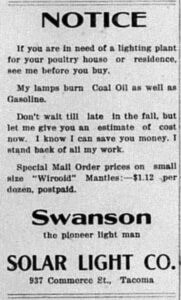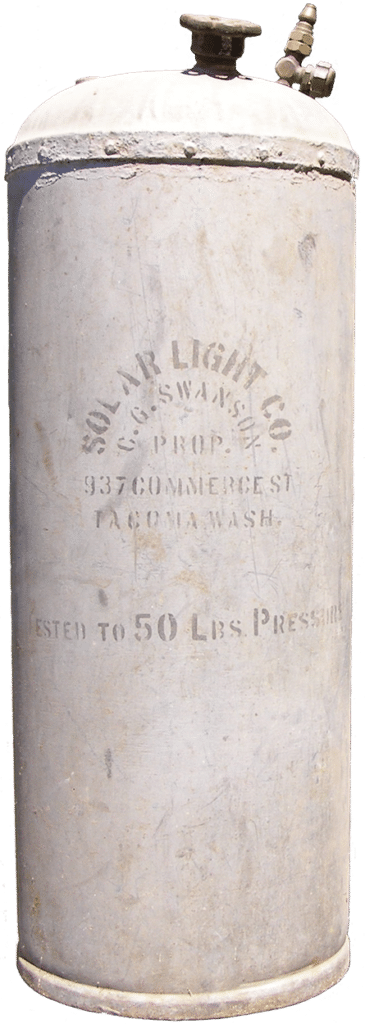Community
Gig Harbor Now and Then: Library hall used a form of lighting your insurance agent wouldn’t approve of
We concluded our last column with the question:
Community Sponsor
Community stories are made possible in part by Peninsula Light Co, a proud sponsor of Gig Harbor Now.

Charles Swanson of Burton, on Vashon Island, sold gas lighting systems through his Tacoma business, the Solar Light Co. This ad appeared in the October 29, 1920, issue of The Bay-Island News, the same week he was installing one of his systems in the Vaughn Library Hall.
What kind of lighting system upgrade was installed in the Vaughn Library Hall in 1920?
Answer: Interestingly enough, the answer lies in that fun little riddle many of us memorized in childhood. For those too young to remember, it goes like this:
How do you make firemen nervous and your insurance agent faint?
Tell them you’re going to light your house with pressurized gasoline!
Well, maybe that’s not quite how it goes, but the answer is there, anyway.
Pressurized gasoline
While the most popular new lighting systems of the day were electric, in 1920 the board of directors of the Vaughn Library Hall chose to light their building with pressurized gasoline, fed through metal tubes in the walls to each lamp in the building. Coal oil could also be used, which at first blush sounds as if it made the setup more versatile than competing electrical systems. But the dual-fuel versatility was offset by the Delco-Light plant’s ability to burn either gasoline or kerosene in its motor.
After the Vaughn Good Roads Club’s “Poverty Masquerade Party” was held under the new bright lights in the hall, The Bay-Island News reported on Nov. 5, 1920, that the upgraded lighting system was being “very much enjoyed by the Vaughnites in general.”
What tipped the balance toward pressurized gasoline for the Hall’s directors isn’t known. However, the fact that the Vaughn Library Hall didn’t burn to the ground— fueled by a pressurized, volatile accelerant — and survived to be revived to its glory over 100 years later, shows that their decision wasn’t necessarily the wrong one. It’s simply one that scares the daylights out of us today.

While the lamps of the misleadingly-named Solar Light apparatus are no longer in the Hall, the fuel tank is, having been found in the dark, dirty, cluttered basement when the renovation first began. When asked recently if the completed restoration of the building will include a fully functioning pressurized gasoline lighting system, project co-manager Paul Michaels said: “No.”
And in sports …
We now switch topics from lighting to scoring. The Gig Harbor and Key peninsulas have been competing against each other in sports for more than a hundred years. During all that time, the girls haven’t had as many opportunities in sports as the boys have, but they’ve always had at least some choices. Today’s question of local history involves two of those sports.
In the 1930s, the several team sports available to local girls were apparently always affiliated with schools, although they did not always play against other school teams. As with most kids’ games, sometimes the results were close, other times lopsided.
In 1930 the girls of Union High School in Gig Harbor beat the girls of Vaughn Union High, 17 to 15.
Two games later, the Gig Harbor girls lost to Olalla, 5 to 4.
In 1935, the girls of Rosedale School trounced the girls of Crescent Valley School by a score of 66 to 22.
Question: What two different sports were the girls playing in 1930 and 1935?
This question’s degree of difficulty is 3 out of 5.
Gig Harbor Now and Then will have the answer two weeks from today. In the meantime, you’re invited to visit the Gig Harbor Now Facebook page and post your guess and other thoughts about today’s question, and read what others have to say about it.
Comments on lighting your home with pressurized gasoline are also welcomed. It’s just a hunch, but I somehow get the feeling not everybody would be in favor of it.
Greg Spadoni of Olalla has had more access to local history than most life-long residents. During 25 years in road construction working for the Spadoni Brothers, his first cousins, twice removed, he traveled to every corner of the Gig Harbor and Key Peninsulas, taking note of many abandoned buildings, overgrown farms, and roads that no longer had a destination. Through his current association with the Harbor History Museum in Gig Harbor as the unofficial Chief (and only) Assistant to Linda McCowen, the Museum’s primary photo archive volunteer, he regularly studies the area’s largest collection of visual history. Combined with the print history available at the Museum and online, he has uncovered countless stories of long-forgotten local people and events.

